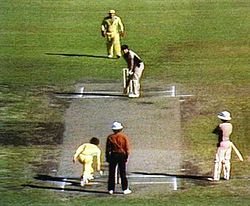Underarm bowling
Underarm bowling is not permitted by
the Laws these days unless a special
agreement has been concluded between the captains
before the match starts. This change was introduced in 2000 in
order to prevent a bowler from rolling the ball
along the ground if the batting side need a boundary
6 to win from the last ball of the match.
Of course underarm used to be the only legal bowling
action until the early part of the nineteenth century when
it was augmented, in 1828, by round-arm and then, in 1864, by
over-arm bowling. Nevertheless underarm bowlers - usually
bowling what were called 'lobs' - were still to be seen
regularly right up to the early 1900s. One of the best-known
English exponents was Digby Jephson, captain of Surrey, who took
6 wickets for 21 runs
for the Gentlemen against the Players in 1899. Although better
known as a batter,
Jephson had actually changed his action
to underarm bowling, having started his career as an over-arm
fast bowler!
But the greatest underarm bowling achievement was probably that
of probably the last man to bowl this way in first-class
cricket, Worcestershire's George Simpson-Hayward. Playing for
England in a five- Test series
in South Africa in 1909, he finished with 23 wickets at an average
of 18 runs, including a remarkable 6 wickets for just 43 runs in
the first Test.


